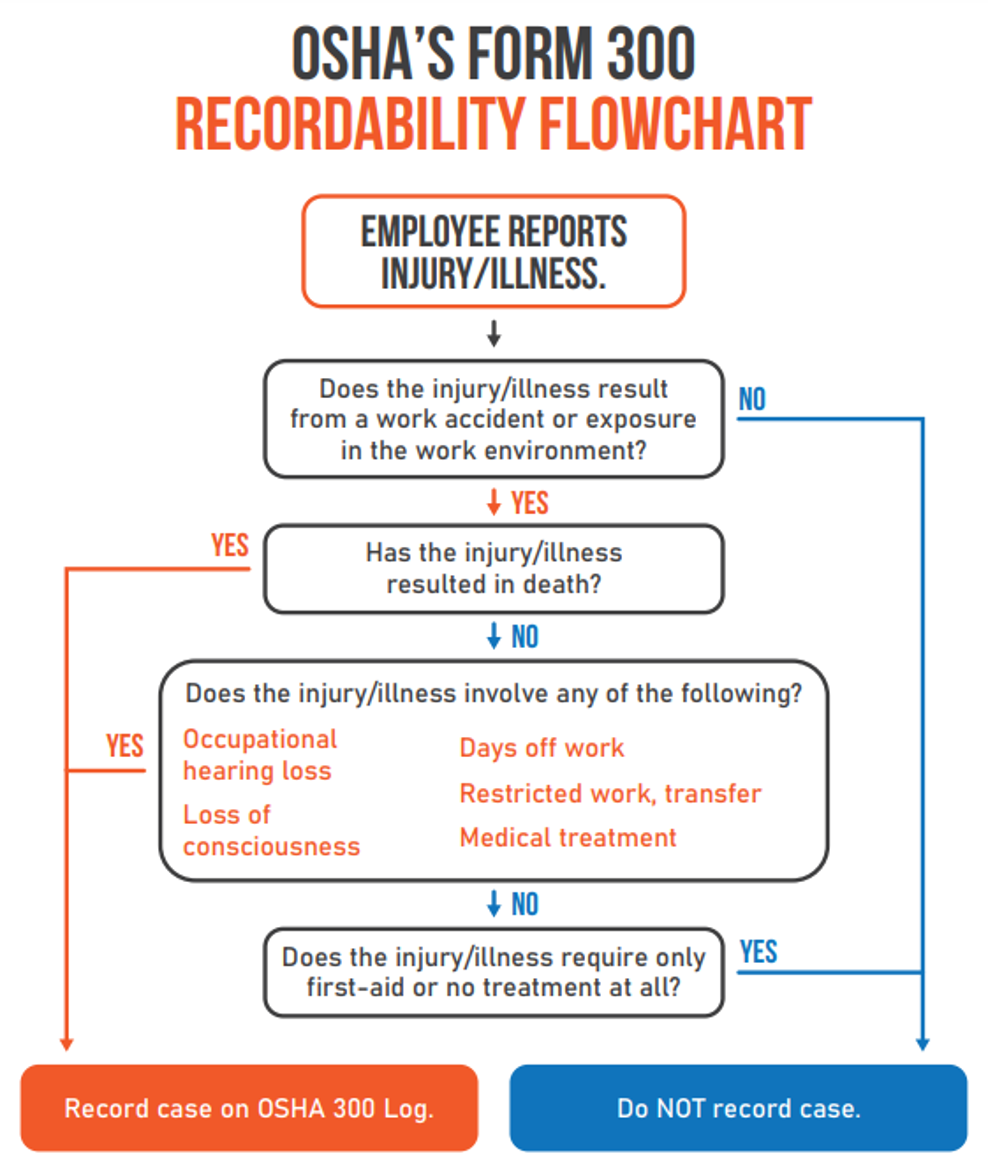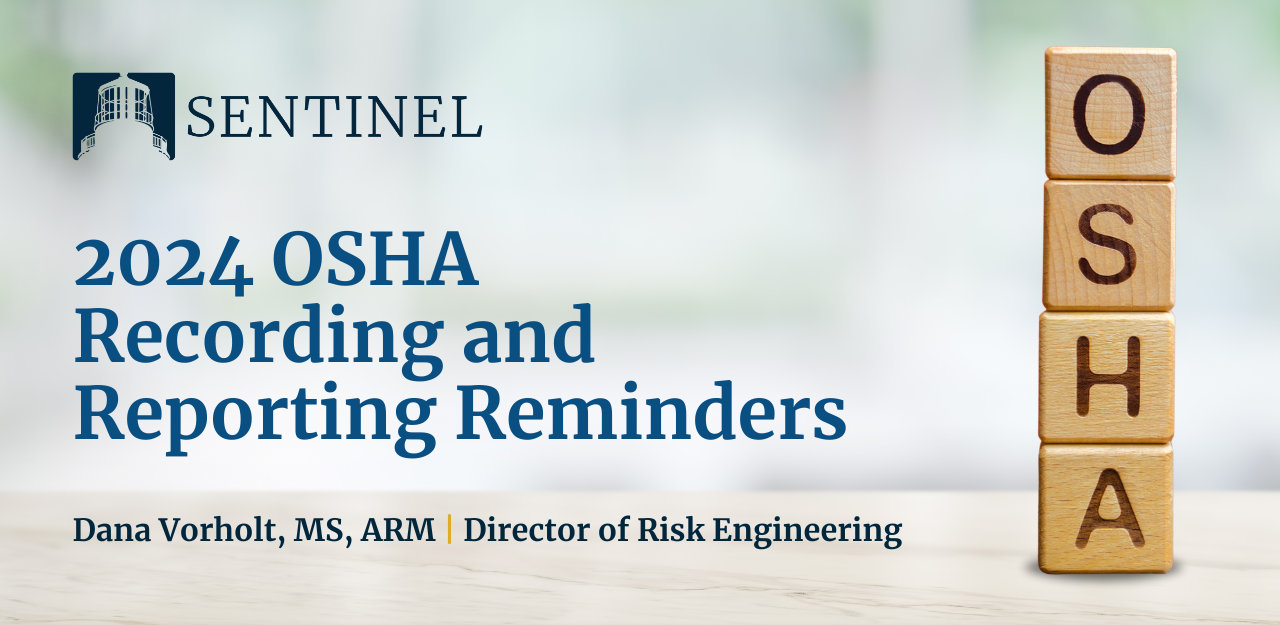You know the holiday season is safely (no pun intended) in the rearview when annual reminders to post OSHA Form 300A reports are delivered to your inbox and blasted on LinkedIn. With this comes a tremendous increase in reporting specific OSHA incidents. Like most tasks we do not often perform, this process can be difficult to complete without proper guidance. The following information should aid you in figuring if you are on the right path, or perhaps need redirection.
Is Your Operation Required to Keep OSHA Injury & Illness Records?
Here are the parameters to help you to determine if you need to record and report incidents:
- 1904.1(a)(1) confirms if your company always had 10 or fewer employees during the last calendar year, you do not need to keep OSHA injury and illness records, unless OSHA or the Bureau of Labor Statistics informs you in writing that you must keep records under 1904.41 or 1904.42. Keep in mind, even if you do not meet reporting requirements, per 1904.39, all employers covered by the OSH Act must report to OSHA any work-related incident that results in a fatality, the in-patient hospitalization of one or more employees, an employee amputation, or an employee loss of an eye.
- If your company is found on this comprehensive list of companies required to report and you meet the size requirements you report: osha.gov/recordkeeping/presentations/covered
- There are 82 “Partially Exempt Industries” that are not required to keep OSHA Injury and Illness Records (unless asked by OSHA in writing to do so). Ironically, insurance carriers and broker services are on this list of exempt employers. If you are on this list, congratulations, you are partially exempted: osha.gov/recordkeeping/presentations/exempttable
How to Define an OSHA Recordable?
There are many scenarios that require reporting, but know that each OSHA recordable will typically meet one of the following categories:
- Any work-related fatality.
- Any work-related injury or illness that results in loss of consciousness, days away from work, restricted work, or transfer to another job.
- Any work-related injury or illness requiring medical treatment beyond first aid.
- Any work-related diagnosed case of cancer, chronic irreversible diseases, fractured or cracked bones or teeth, and punctured eardrums.
- There are also special recording criteria for work-related cases involving: needle sticks and sharps injuries; medical removal; hearing loss; and tuberculosis.

When you WOULD NOT require an employer to report an Injury & Illness on the OSHA Log:
1904.5(b)(2) You are not required to record injuries and illnesses if:
(i) At the time of the injury or illness, the employee was present in the work environment as a member of the general public, rather than as an employee.
(ii) The injury or illness involves signs or symptoms that surface at work but result solely from a non-work-related event or exposure that occurs outside the work environment.
(iii) The injury or illness results solely from voluntary participation in a wellness program or in a medical, fitness, or recreational activity such as blood donation, physical examination, flu shot, exercise class, racquetball, or baseball.
(iv) The injury or illness is solely the result of an employee eating, drinking, or preparing food or drink for personal consumption (whether bought on the employer’s premises or brought in). For example, if the employee is injured by choking on a sandwich while in the employer’s establishment, the case would not be considered work-related. Note: If the employee is made ill by ingesting food contaminated by workplace contaminants (such as lead) or gets food poisoning from food supplied by the employer, the case would be considered work-related.
(v) The injury or illness is solely the result of an employee doing personal tasks (unrelated to their employment) at the establishment outside of the employee’s assigned working hours.
(vi) The injury or illness is solely the result of personal grooming, self-medication for a non-work-related condition, or is intentionally self-inflicted.
(vii) The injury or illness is caused by a motor vehicle accident and occurs on a company parking lot or company access road while the employee is commuting to or from work.
(viii) The illness is the common cold or flu (Note: contagious diseases such as tuberculosis, brucellosis, hepatitis A, or plague are considered work-related if the employee is infected at work).
(ix) The illness is a mental illness. Mental illness will not be considered work-related unless the employee voluntarily provides the employer with an opinion from a physician or other licensed health care professional with appropriate training and experience (psychiatrist, psychologist, psychiatric nurse practitioner, etc.) stating that the employee has a mental illness that is work-related.
Is my company affected by the new rule expanding submission requirements for injury, illness data?
The Department of Labor finalized the rule that will require certain employers in designated high-hazard industries to electronically submit injury and illness information. The good news here is that the employers who are required to report are already required to keep this information on file.
OSHA will publish some of the data collected on its website to allow employers, employees, potential employees, employee representatives, current and potential customers, researchers, and the general public to use information about a company’s workplace safety and health record to make informed decisions. OSHA believes providing public access to the data will reduce occupational injuries and illnesses. This impacts:
- Establishments with 100 or more employees in certain high-hazard industries must electronically submit information from their Form 300-Log of Work-Related Injuries and Illnesses, and Form 301-Injury and Illness Incident Report to OSHA once a year. These submissions are in addition to the submission of Form 300A-Summary of Work-Related Injuries and Illnesses.
- To improve data quality, establishments are required to include their legal company name when making electronic submissions to OSHA from their injury and illness records.
- This rule took effect on January 1, 2024; however, employers have until March 2, 2024, to complete this submission.
OSHA Reporting Questions Sentinel Is Frequently Asked:
Question: When do I post my OSHA Form 300A (Annual Summary)?
Answer: Each year from February 1st to April 30th, covered employers must post their 300A Summary in the workplace for the previous year’s injuries and illness.
Question: If an employer has no recordable cases for the year, is an OSHA 300-A, still required to be completed, certified, and posted?
Answer: Yes. After the end of the year, employers must review the Log to verify its accuracy, summarize the 300 Log information on the 300A summary form, and certify the summary on those dates noted above – Feb. 1st – April 30th.
Question: If the business has multiple locations can the injury & illness recording & reporting Form 300A be kept as one large record at the main office or must a form be kept at each location?
Answer: You must have separate records that pertain to each establishment. You may keep the records for an establishment at your headquarters or other central location if you can: (i) Transmit information about the injuries and illnesses from the establishment to the central location within seven (7) calendar days of receiving information that a recordable injury or illness has occurred; and (ii) Produce and send the records from the central location to the establishment within the time frames required by § 1904.35 and § 1904.40 when you are required to provide records to a government representative, employees, former employees or employee representatives.
Safeguarding Your Success
When I said we see a tremendous increase in the number of questions for OSHA reporting from our clients this time of year, I meant it. OSHA Record-keeping tends to provide a challenge for our clients and partners, and rightfully so. Why would anyone think you would record weekends, holidays, and vacation days in the “Days Away from Work” section when an injury occurs? Employees do not typically work on those days, so it might not seem logical to report on those days – but according to OSHA, you need to! Per 1904.7(b)(3)(iv), “You must count the number of calendar days the employee was unable to work as a result of the injury or illness, regardless of whether or not the employee was scheduled to work on those day(s). Weekend days, holidays, vacation days or other days off are included in the total number of days recorded if the employee would not have been able to work on those days because of a work-related injury or illness.”
In the end, there are many reasons behind the “Do I or Don’t I” scenarios of OSHA recording. Part of that puzzle piece was noted in the opening paragraph, specific to the fact information is only reported once a year. The other part might be a little bit of OSHA overcomplicating the process. For those on the side that feel OSHA might make it more complicated than it needs to be, this Exhibit A that will support your stance on how confusing it can sometimes be: https://www.osha.gov/laws-regs/standardinterpretations/1997-09-02
Another reason that companies and organizations might find it difficult to navigate the OSHA record-keeping process, is the simple fact that the employee tasked with this responsibility does not always work in the area of risk. There are so many different variables and scenarios that can and will occur over the course of a year when it comes to injuries, that it can be difficult to determine if an incident is recordable.
That said, since we did not write the standards, Sentinel can simply provide guidance on how they need to be implemented – so don’t shoot the messenger. The problem is that you either must know where to find the answer or have experience navigating the nuances found within OSHA when it comes to this standard. This is where Sentinel can assist you with those one-off situations or scenarios. If you find yourself trying to navigate a difficult case that did not come to you in the form of black or white, please reach out and we will get you on the right track!
Lastly, we should give OSHA a ton of credit in many areas. They were touted as a small agency on a big mission, and there is no question their existence has saved many lives and drastically improved workplace conditions for workers across the United States. As complicated as processes such as recording and reporting can sometimes be, OSHA does a great job in providing direction and resources for nearly every scenario thinkable – which as a consultant who works closely with companies, I am immensely thankful for!


